By Darcy Schild | May 3, 2019
Young women draw strength from an ancient art form that is often misunderstood in America
Dance Studio A is tiny, a bare-bones box of a room next to a printing lab in the basement of the University of Florida’s student union. Unless you’re specifically looking for it, you might walk right past it. Despite the music that’s making the walls bump, mobs of people outside the studio are studying and milling about as usual — headphones on, world (and all other surroundings) off.
But each Monday evening, a group of women transforms this dinky dance room ripe with the smell of stale sweat and bare feet into a sacred space. Outsiders don’t know, and perhaps many of them don’t deserve to know, about these four walls full of laughter and love and light — and a whole lot of shimmying.
Inside the studio, Caty Macfarlane’s shimmies and steps in time with Ariana Grande’s “7 Rings.” A blanket of dark brown ringlets — tight like mattress coils — sways back and forth, creating a curtain of curls against the small of Macfarlane’s back.
My wrist, stop watchin’, my neck is flossin’. Make big deposits, my gloss is poppin’.
Wearing a turquoise, mid-length mesh coin skirt over black leggings and a wrinkled grey t-shirt, Macfarlane looks like any other comfy college girl who picked out whatever clothes were clean that morning — but one who also happens to be a part-time mermaid.
“If you don’t see your stomach rolls, you’re not doing it right,” Macfarlane says into the mirror, reassuring her class of eight women that the elegant body undulation required in belly dancing— despite how effortless and fluid she makes it look — takes practice, poise and a lot of self-trust.
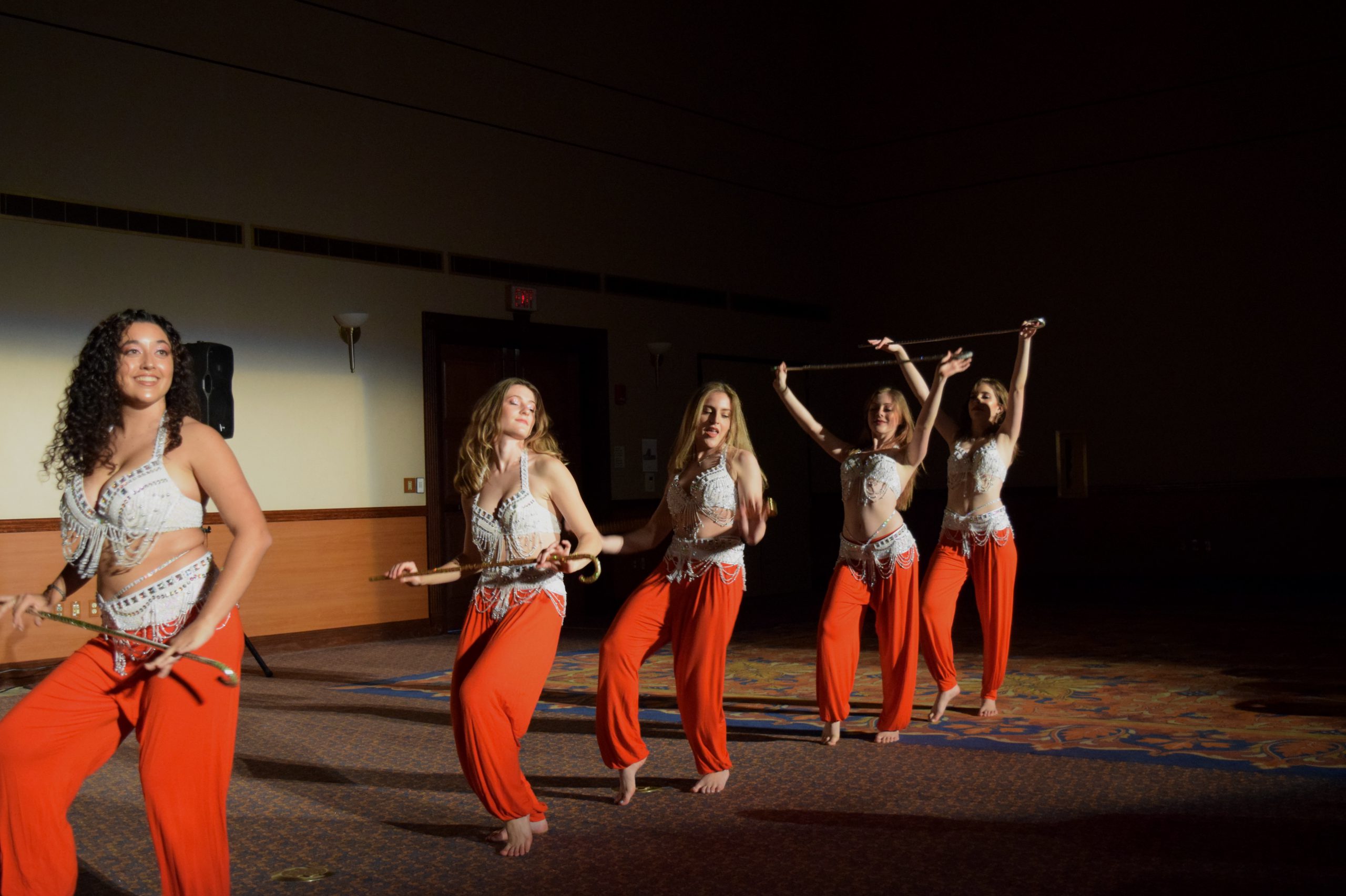
LOVE, LIGHT AND LAUGHS: The Belly Gators practice and perform celebrate and express themselves through belly dance, an ancient art form with Middle-Eastern roots. Some women on the team learned this style of dance at a young age, while others shimmied for the first time during classes hosted by the campus organization. (Darcy Schild/WUFT News)
The origins of belly dance have long been contested. Some dance theorists link the first belly dance-like movements to ancient fertility rituals from Mesopotamia. Today, the belly dance community welcomes people of just about every culture, age and experience-level — and the dance can be practiced in many styles. The Belly Gators practice the American Cabaret style, a fusion of western and Egyptian-inspired technique. But if belly dance is anything, it’s a vehicle of self-expression that encourages movement and emotions beyond the confines of a specific style. It’s rooted in tradition yet can be performed to the beat of Top 40 hits. It’s ancient but relevant. And for those who practice it, there are stories behind the shimmies —of friendship, sisterhood and self-love.
The other women emulate Macfarlane’s full-body roll in the mirror. Some watch themselves and laugh at what they claim is not-quite-there technique.
“Oh my gosh, I’m definitely not doing this right!” says one.
Some ask each other if maybe they need to lift their hip more, or go a little higher on their tiptoes.
“Let’s try it again,” Macfarlane says.
She pauses the music with a quick tap of her Apple Watch, barely blinking, let alone allowing herself to take a breath or wipe her hair out of her face.
“This time, don’t be afraid to just go for it.”
The women close their eyes and let the music flow through them. They keep their gaze glued to the mirror, watching Macfarlane’s artfully fluid, meticulous-looking movements. The women follow her lead, creating a cocktail made of their own organic movements — twirling and twisting their wrists and curling their fingers — and the synchronized shimmies that match the choreography.
Macfarlane presses “play,” and again, the girl-power anthem blasts through the walls of Dance Studio A.
I see it, I like it, I want it, I got it.
Each word in the chorus commands the women in the room to move in time; hip raise, step-ball change, shoulder shimmy, head flick.
This is just the warm-up.
The accidental belly dancer
Class ends an hour later and the seven women, who just poured their hearts and souls into an artful and ancient dance form, pull sweatshirts over their heads and wipe sweat from their upper lip. Macfarlane calls them to the center of the room for the team’s traditional chant, called a Zaghareet — a loud, trilling sound common in belly dance culture.
“1, 2, 3, Shimmy Sisters!” Macfarlane says and the women follow, cupping their fingers over their mouths and letting out the high-pitched screech.
With it, the women are gone and Macfarlane is left alone in the studio, which now feels cold and bare without the others. She unplugs her iPhone from the sound system and unties the turquoise coin skirt and lets it drop to the floor, the metallic pieces making an echo-y clink sound on the hardwood floor.
If it weren’t for her affinity for teen pop music and her backpack with her iPad and homework to-do list, it would be easy to mistake Macfarlane for a grown woman who inherited the art of belly dance from her relatives. Her flowing hair reaches the small of her back, and her facial structure — with her long, sculpted nose and deep brown eyes — makes her look older than the 21-year-old she is. People who see her dance assume she is of Middle-Eastern descent (which is where belly dance has its roots) but she’s actually half-Irish, half-Dominican, and she didn’t grow up in a family or culture where belly dance was a meaningful art form or something that was passed down from generation to generation.
You might call her the accidental belly dancer.
Macfarlane’s journey began when she was 8 — simply because she wanted to try it — and her love for belly dance catapulted her as president of the Belly Gators, UF’s student-run belly dancing club.
Macfarlane checks her phone. The Belly Gators’ lively Facebook group message is already blowing up with texts about the next rehearsal for the team’s annual showcase, only a month away.
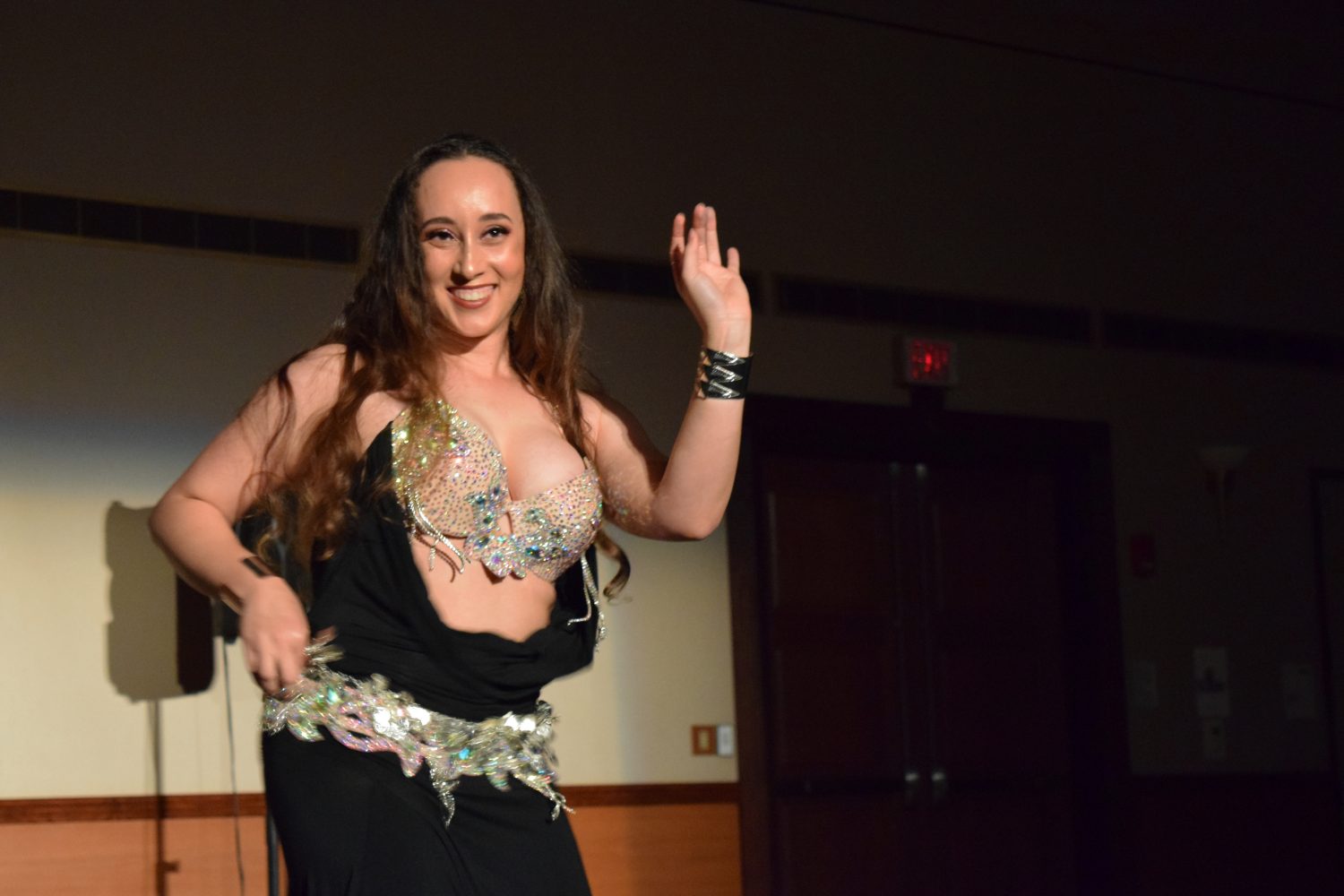
The Belly Gators perform at student events on campus and sometimes in the Gainesville area, but the annual showcase, or hafla (Arabic for “party” or “gathering”), is the group’s most important performance of the year. The student belly dancers perform every routine they’ve learned in the past year, and many invite friends, roommates or partners to share the magic of their community.
“ok sooo when can we practice the fan veil number?” messages Kat Kirchman, the Belly Gators’ marketing director and self-proclaimed “Momager” (combination of “mom” and “manager”) of the team.
Other members immediately “thumbs up” the message.
Macfarlane shuts off the studio lights, looks at her calendar and clicks her tongue while she thinks of a good time to have another dance rehearsal this week.
“I’ll have to see when the dance studios are available,” she replies to Kirchman.
Macfarlane wants this year’s hafla to be a success. This is her first year as president of the club; it’s also her first time leading the year-end showcase. Mostly, Macfarlane is eager to show an audience who may have never seen belly dancing before what the art form means to her.
The story behind the shimmies
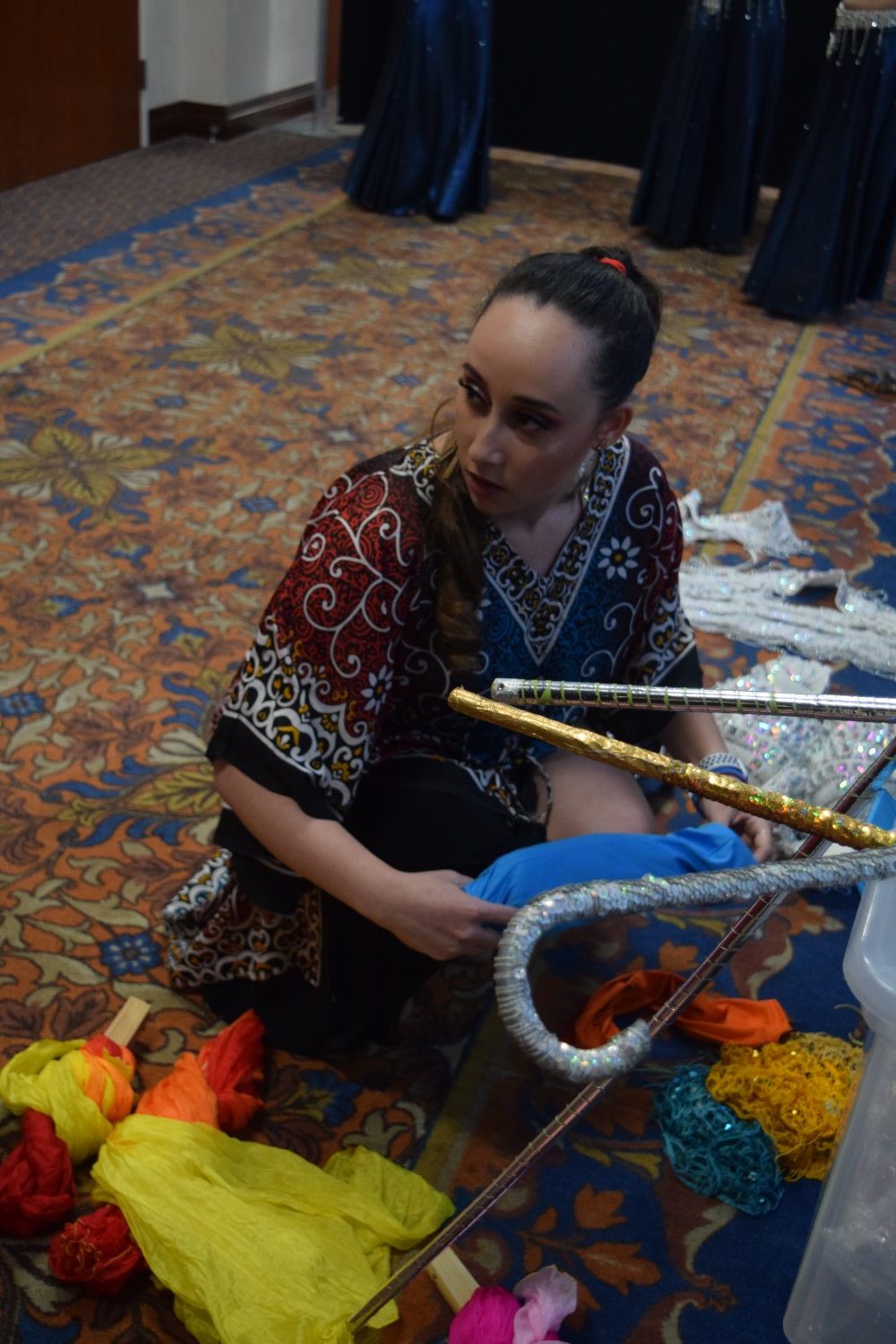
It’s 9 at night before Macfarlane gets home to her loft-style duplex that’s far away from student housing near campus. Inside, the walls are white cinderblock, and the tall ceilings make the space seem cold and industrial.
She has her work cut out for her tonight; she has to study for a quiz on Wednesday and is preparing for what she calls a “pretty quick performance” for an on-campus performance the Belly Gators were asked to do for GatorWell, a student health organization.
She spends anywhere from three- to six-hours each week performing routines with Belly Gators dancers outside of the weekly Monday classes. And she spends much of her spare time taking belly dance classes of her own at a studio in Gainesville.
From the outside, it seems Macfarlane’s life is eat, sleep, belly dance. And that’s a fair portrayal. But for Macfarlane, belly dance is more than a hobby or a good workout; it’s a way of living and thinking, even when she’s off the dance floor. It’s apparent when her eyes glimmer each time she presses “play” on a new routine for the Belly Gator team, and it’s obvious when she gets to practice early to show the Belly Gator team members a YouTube video of a belly dance star performing an complicated- movement. She sometimes even trapezes around her apartment kitchen, making otherwise mundane movements like grabbing a banana from the fruit bowl into a mini-performance.
Long before she knew a hip shimmy from a hip shake, Macfarlane was a Junior Olympic-level swimmer who spent most of her hours at the pool. She enjoyed swimming as a sport, but she felt something was missing and longed to spend her time doing something more artistic and freeing.
One day after swim practice, Macfarlane, an only child, asked her mother if she could try another activity. Her mother signed her up for a martial arts class.
Macfarlane still remembers hopping out of her mom’s mini-van and into the taekwondo studio in a musty shopping plaza in Hollywood, Florida, near where she grew up in Miami. Through a window, she caught a glimpse of a group of women practicing belly dance. She stood outside, entranced at how gracefully they moved.
Macfarlane immediately asked her mom to sign her up for those classes.
To watch Macfarlane move now, it’s hard to imagine she was ever a novice. But she distinctly remembers her first belly dance class. She was 8 and it was intimidating.
She was then skin and bones and muscles. Swimming gave her strong, broad shoulders that made her look and feel stiff and boxy, unlike the other girls in the class, many of whom were a few years older. They had the beginnings of curves and wore cute coordinated athletic clothes. Macfarlane thought she looked awkward even in the most basic belly dance warmup stretches. The mirror was not her friend. But through the guidance of her first teacher, a dancer named Shayna, Macfarlane learned that being a belly dancer is not about looking a certain way; it’s about experiencing what she calls tarab, an Arabic word she describes as a euphoric feeling when a person is so into the dance, the music and the movement that their soul dances along with it.
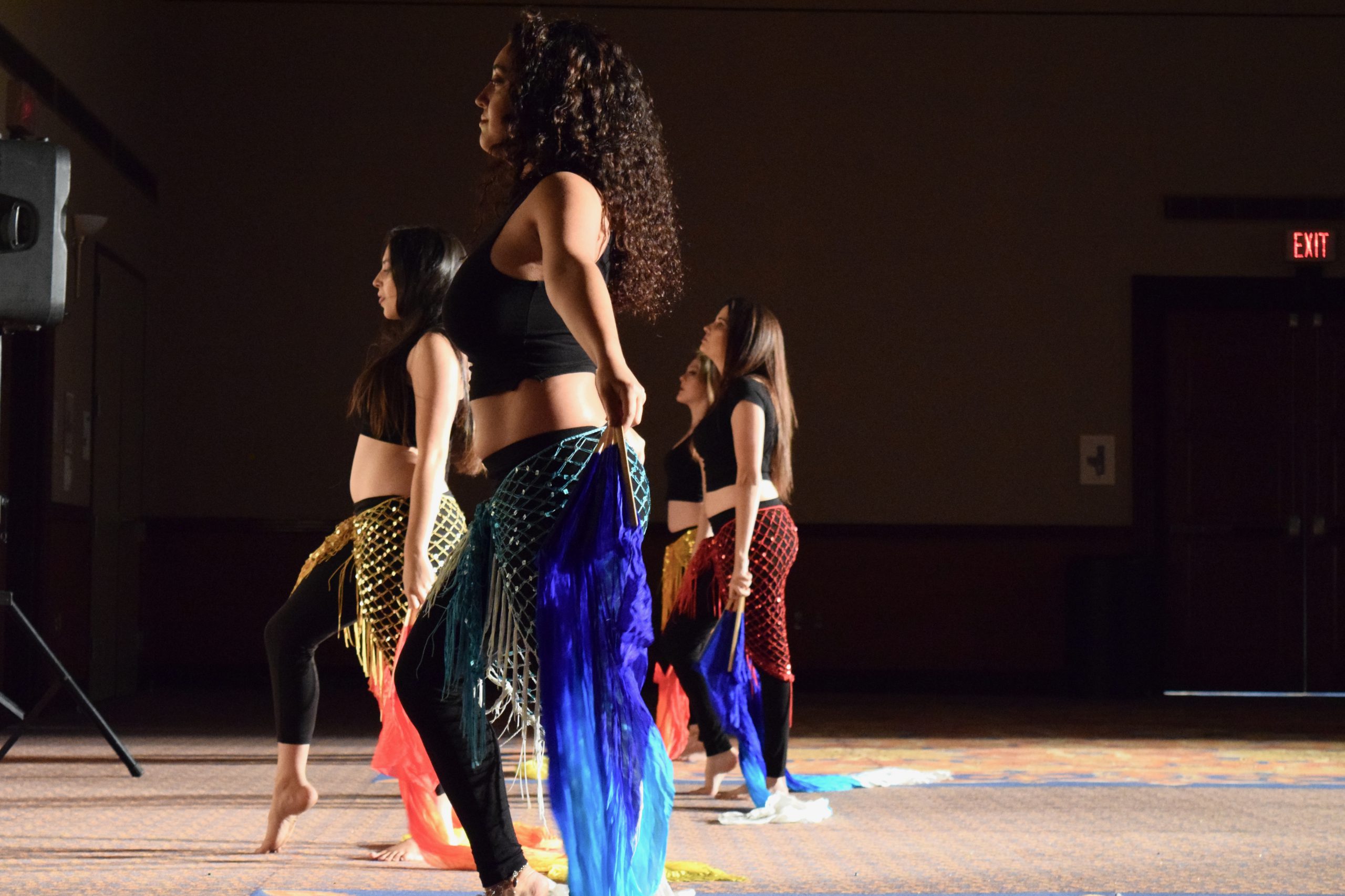
On Macfarlane’s first day of class, Shayna gave her pennies to hold between her thumb and middle fingers to help her learn traditional belly dance hand gestures. The hand placements, and nearly everything about the style of dancing, felt foreign to Macfarlane, but she aspired to have the poise of the older girls in the room, whose shimmies were smooth and whose feet floated across the ground.
But a few years after that uncomfortable start, Shayna invited Macfarlane to join the dance club’s traveling belly dance troupe. Macfarlane was the youngest member of the group.
Now, a dozen years after her first class, Macfarlane is leading a team of her own.
But belly dance isn’t always sparkles and fun. Macfarlane often finds herself debunking stigmas of belly dancers as pole dancers. She says she sometimes feels apprehensive telling a guy she meets for the first time that she’s a belly dancer — because in the past, men have responded with sexualized or derogatory remarks, like “Do a dance for me.”
But the Belly Gators’ fast-approaching annual performance is a time for Macfarlane to share with the rest of the world that belly dance is far from burlesque; that it is an art form that adds meaning to her life.
Sisterhood beyond the studio
One Saturday night, Macfarlane hosts the Belly Gators at her apartment for a sleepover to unwind outside of the dance studio.
Unsurprisingly, an upbeat Ariana Grande Spotify playlist (the Belly Gators’ practice music of choice) fills the apartment — as if the women haven’t heard these songs a million times already in dance rehearsal. Macfarlane twirls around the kitchen as she pours a bowl of yellow batter into cupcake tins, and on the couch, two of the Belly Gators, Patricia Concepcion and Kat Kirchman, are curled up on the couch. Concepcion advises Kirchman, who’s scrolling through her latest potential suitors on Bumble.
“Ehhh… what you do think?” Kirchman asks, showing a photo from a dating app to Concepcion for what seems like the thousandth time.
The two women are, without a doubt, core members of the Belly Gators crew. They’re at every practice, and, along with a handful of other team members, they’re reliable with attending performance rehearsals.
Kirchman has been a part of the Belly Gators since last spring. She’s loved by her teammates for her honesty and humor. She always shares her two-cents, but in a lovable way.
She decided to learn belly dance as a means of exploring her family’s Middle-Eastern heritage. She grew up in Boca Raton, Florida, and her dad’s side of the family is Lebanese. She’s been belly dancing for nearly a year, and practicing the ancient dance that has roots in the Middle East has made her feel more connected to her family.
Now, when Kirchman posts belly dance videos on Facebook, her cousins (some of whom she’s only met once, when she was little) sometimes react with “Likes” and heart Emojis. They give Kirchman a sense of belonging.
Concepcion is soft-spoken and gentle. She’s affectionately thought of as the baby of the Belly Gators group — partly because she’s the youngest team member, and also because she has the quintessential look of a little girl.
She learned to belly dance when she was growing up in Cuba. When she was 8, she asked her mom to take her to a belly dance class after she watched the music video to Shakira’s “Hips Don’t Lie.”
“I’m not kidding! I literally wanted to be Shakira!” Concepcion tells her friends.
When her family moved to Miami during her teens, classes became unaffordable and Concepcion was forced to put her belly dance dreams on hold.
It wasn’t until this past summer, when she was visiting Gainesville for her new student orientation session, that she longed to return to her belly dance roots. She asked her group leader if UF had a group she could join, and she showed up to practice as soon as school started in August.
Concepcion, no stranger to moving from a place that feels familiar, feared she would be lonely in Gainesville. Macfarlane and the Belly Gators saved her.
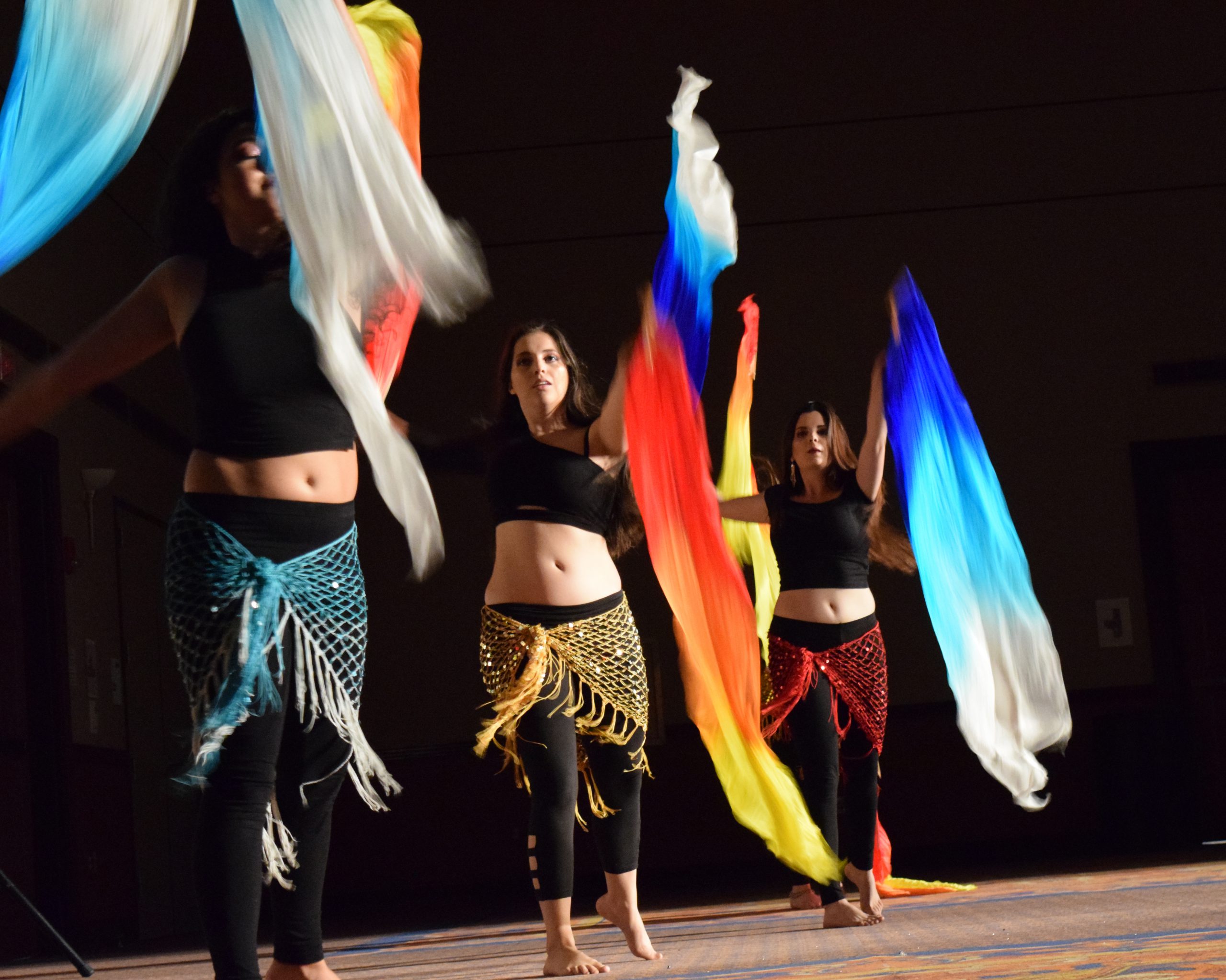
Pressure to perform
On an early March morning the lights are dim in Dance Studio A.
The only sound is the faint ticking of the wall clock; the big hand marks 8 a.m. With only two weeks left until the hafla, each tick and tockseems to symbolize how quickly time is going. The pressure is on for Macfarlane to put on a great show, but not all team members can make time for multiple practices per week, which worries her.
Macfarlane is the first one in the studio. She’s waiting on five other dancers who are meeting to practice one of the more complicated numbers in the hafla lineup — a routine that the women haven’t practiced together in at least a month. She’s often had to wait for the others to show up on time for rehearsals.
The song for the routine is a mix of vocals from “Turning Tables,” a ballad by Adele, and more modern, electronic instrumental beats. The dance requires special attention and extra practice because the women use props called fan veils — big pieces of glossy, metallic fabric that are visually stunning but can be tricky-to-maneuver. When used correctly, the pleated sheets create the effect of flowing water, but in punchy oranges and reds and yellows. But the veils drag along the ground and the dancers can easily trip on them. That would make for a major hafla faux pas.
Macfarlane is anxious to begin dancing. Why are the others late?
“Where is everyone??” Macfarlane asks in a group text.
Two people read the message, but no one responds.
A half hour goes by. It seems eternal to Macfarlane.
“Sorry we’re laaaaaate!” Kirchman sings as she and Concepcion arrive. “But we’re here, right?”
Macfarlane leans against the wall, runs her hands through her hair, exasperated and frustrated that some people aren’t showing up to this important rehearsal.
“We’re missing half the people for the number,” shesays.
Kirchman picks up one of the fan veils Macfarlane laid out on the wooden floor, twirling it over her head.
“I mean, that doesn’t mean we can’t practice, right?” Kirchman asks.
Macfarlane shrugs and scrolls through her phone to find the routine soundtrack.
“We’ll just go through it once anyway,” she says.
Macfarlane presses play, and the song’s passionate piano tune fills the studio.
She marks time, narrating each part of the chorography with phrases like “1, 2, 3, heel drop” and clicks of her tongue that match in time with the beat of the song.
“Aaaaand stop,” she says at one point.
“Wait, what did we do wrong?” Concepcion asks.
“Nothing, nothing is wrong, but remember to think about the layers in the song and bring emotion into every step,” Macfarlane tells them. “Remember how a few weeks back I talked about layers? It’s up to you to bring out each layer through your movements and decide what story you want to tell.”
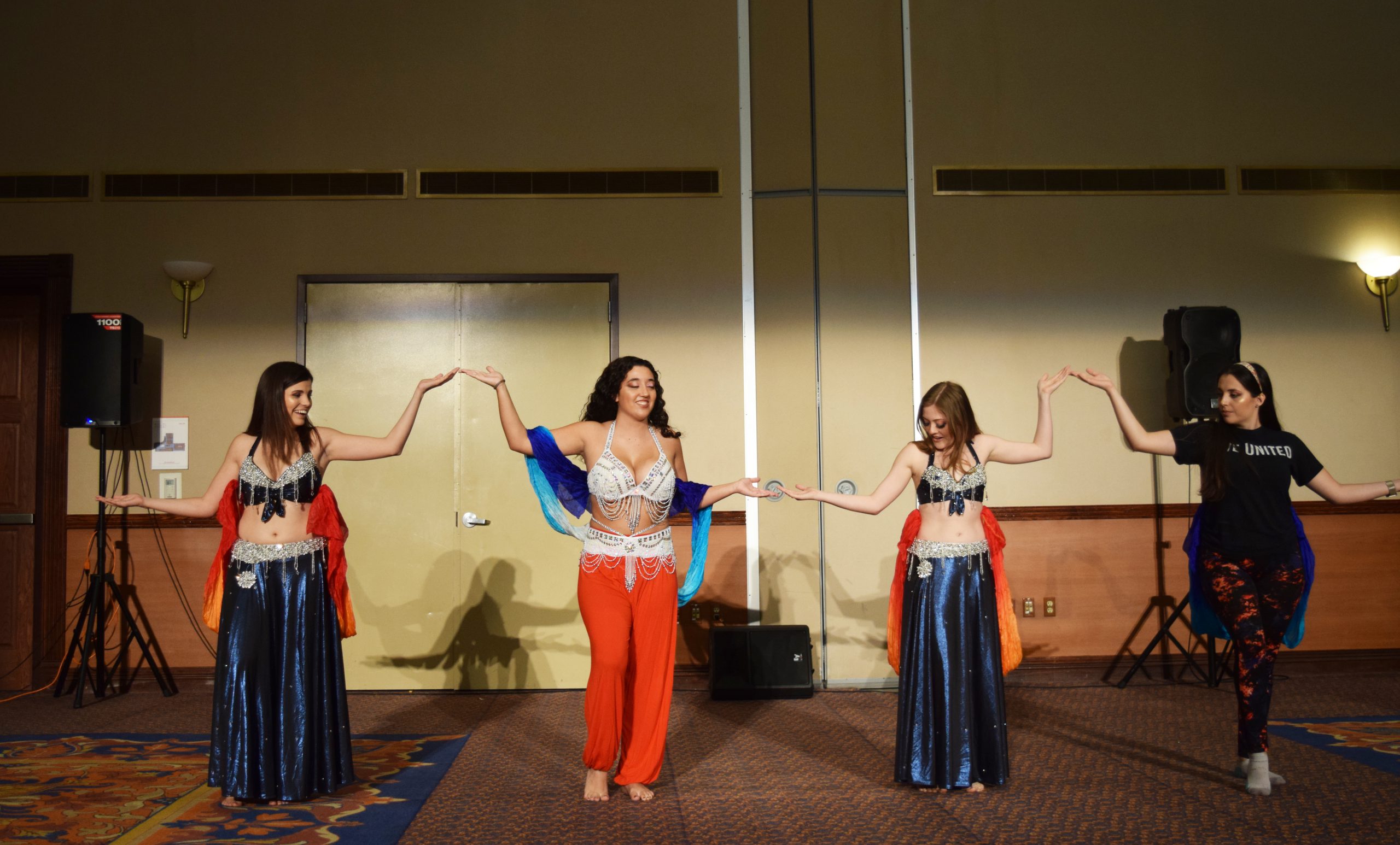
Macfarlane stands up and mimics the routine’s movements — she steps delicately, shifting her weight from side-to-side on the balls of her feet, while twirling a silky silver fan veil in a squiggly shape.
Then, she does it again, but this time, each step and movement she makes has passion and power; she even closes her eyes and lets her head fall back.
“See the difference? How the second time, I let go a little bit and just thought about the sounds and how I’m adding my own feeling to the dance?” she asks rhetorically. “Remember tarab — it’s something you feel during your dance when you just feel so happy, so euphoric.”
“Let’s do it again,” Macfarlane says. “Just be free and don’t worry so much about doing everything perfectly.”
This time, Kirchman and Concepcion revert to their original positions, and when the music starts, there’s a fire in their eyes. A combination of the thoughtful, meticulous, complex steps and shimmying movements and the glimmering, vibrant fan veils makes the otherwise bland dance studio feel like a moving art exhibit, an aquarium with colorful fish moving gracefully through deep blue waters, a place so special and unique and filled with emotion.
The routine may not be perfect, and not all dancers may know the steps and fan veil movements before the hafla, but as Macfarlane watches her dancers tell their stories through the powerful routine she created, even in the dark room, her eyes shine with hope. Maybe things will come together after all.
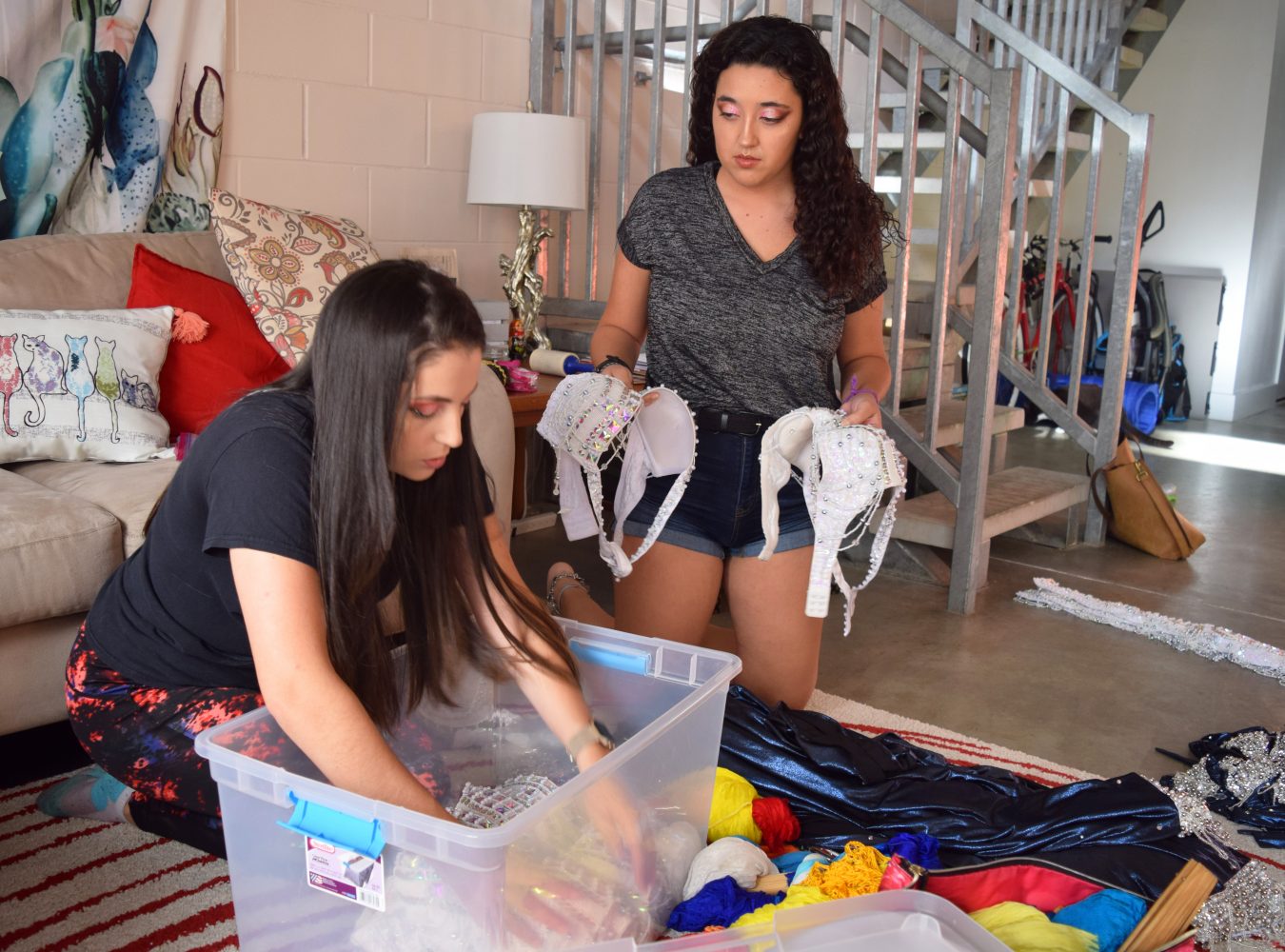
Mascara and morale
At 10 a.m. on March 15, the day of the hafla, the Belly Gators group message lights up with a message from Macfarlane: “Lmk when you guys are on your way, I’m up and ready!”
The performance is 10 hours away but Macfarlane is ready to start doing hair and makeup.
With four hours before showtime, Macfarlane’s apartment looks like the backstage of a Project Runway episode. Kirchman sits cross-legged on the living room carpet, casually arranging a pile of rhinestone-encrusted bras, which are part of the costumes for the performance.
From hot hair tools to phone chargers and speakers, every electrical outlet in the apartment is occupied, and no wonder there isn’t a blown fuse.
On the kitchen table is a heating container of eyebrow wax that’s almost being pushed off the end of the table, thanks to the smorgasbord of makeup occupying the rest of the surface. The collection contains makeup brushes of every size and shape, hairspray cans in every color and a thick smog of glittery eyeshadow.
“Neutrals is not in my vocabulary,” Macfarlane says of the sunset-inspired makeup look she has created for the performance.
Macfarlane is an artist in her element as she expertly mixes powders of pinks and purples and holographic golds, creating a smoothie of shimmery color on the bare eyelids of Scarlett Payne, a petite, blue-eyed strawberry blonde who has been dancing with the Belly Gators for two years.
With each brushstroke, dot of rosy cheek color and mist of hairspray, Macfarlane transforms woman after woman from student-coming-from-class to hafla-ready goddess.
Any pre-show jitters are masked by the fun, chaotic hair and makeup operation — but the clock is ticking, and Macfarlane has yet to hear anything from a few team members, including Concepcion.
“Hey Anna, can you call Patty and see where she is? I know she was supposed to come here and get her makeup done, but I’m getting worried,” Macfarlane says.
Furious texting reveals that Concepcion is on a bus stuck in traffic. And that her boyfriend has just broken up with her on the phone.
Makeup brushes hit the table with a clank. Even though the nearby speaker was blasting Spotify’s “Pop Rising” playlist, there’s a thick silence in the air.
Everyone loves Concepcion. They don’t want to see her heartbroken — especially on a show night.
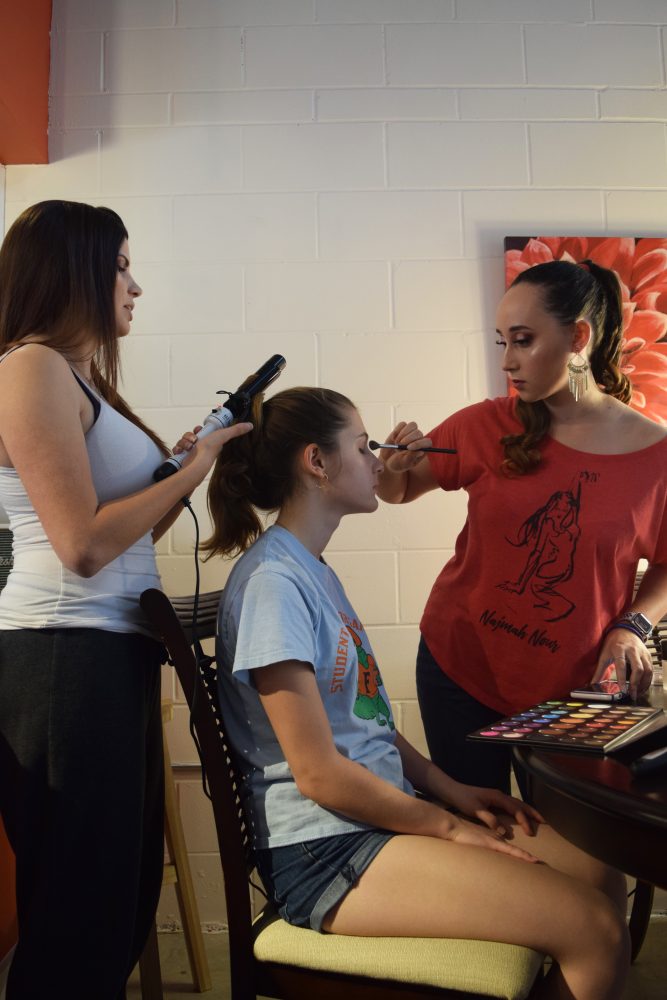
Concepcion finally arrives with puffy eyes and runny mascara. She drops her backpack on the ground, slumps into one of the kitchen table chairs and bursts into tears.
“I don’t think I can dance tonight,” she says in-between gasps. “It’s just like, really? On the bus coming here? Over the phone? What am I supposed to do?”
The women surround her with hugs, back scratches and tissues. Macfarlane gives her a makeup wipe.
“Shh . . . it’s OK, breathe,” Macfarlane says. “We’re gonna make sure you’re all good to go, we’re doing your hair and makeup, and you’re gonna be great. And then you’ll just shimmy it all out and it’ll feel so good.”
“At least this happened while I’m here with you guys,” Concepcion says, pulling her hair in a ponytail while Macfarlane dusts highlighter on her cheekbones.
The show must go on.
Macfarlane’s phone alarm begins to ding. It’s an hour until showtime. She has perfected the face of every woman in the room, except her own.
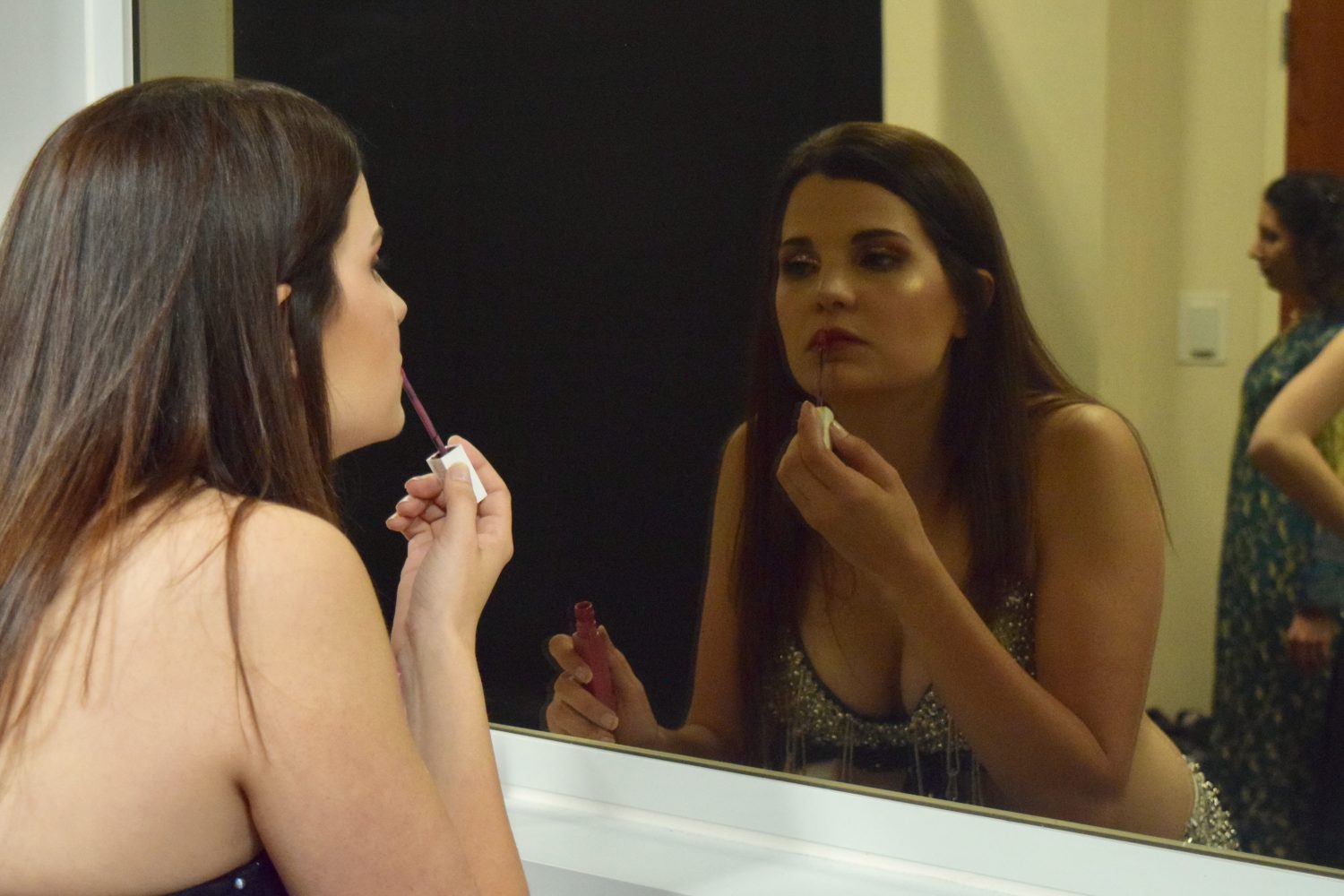
‘When in doubt, just shimmy’
Backstage at the student union, the women swipe last-minute gloss on their lips, adjust their costumes and take Snapchat selfies. This is it. In a few moments, they will go out there and do what they have been working so hard to perfect all these months.
Macfarlane emerges from the women’s bathroom in a floor-length, mustard-yellow patterned robe. Under it is her costume for her solo that she’ll perform at the end of the night, but she wants to keep it a surprise for now. Her curly hair is styled with glossy gel, and she holds a clipboard with the list of routines and the names of the dancers in each. Her heart pounds as she periodically peeks through the doors that lead into the performance area. A crowd of people are filing into the spacious ballroom. And her heart beats a little bit faster.
“Ladies, let’s do finishing touches and get ready and do a little circle before it’s time,” she says.
The women put their phones in their bags, take final deep breaths, add one more bobby pin to their hair-sprayed locks and step into the middle of the backstage area, where Macfarlane’s arms welcome the whole team into a big hug.
“You all look beautiful,” she says. “But most importantly, you all are beautiful, inside and out. And I’m so thankful we’ve gotten to share so much with each other, and that we’re about to share it with so many more people tonight.”
She pauses, her eyes twinkling.
“I’m just so proud of all of you,” she says. “When in doubt, just shimmy it out.”
Macfarlane opens the doors to the ballroom, and the spotlight basks on. Her silhouette is elegant, poised, graceful. She steps further into the light, microphone in hand.
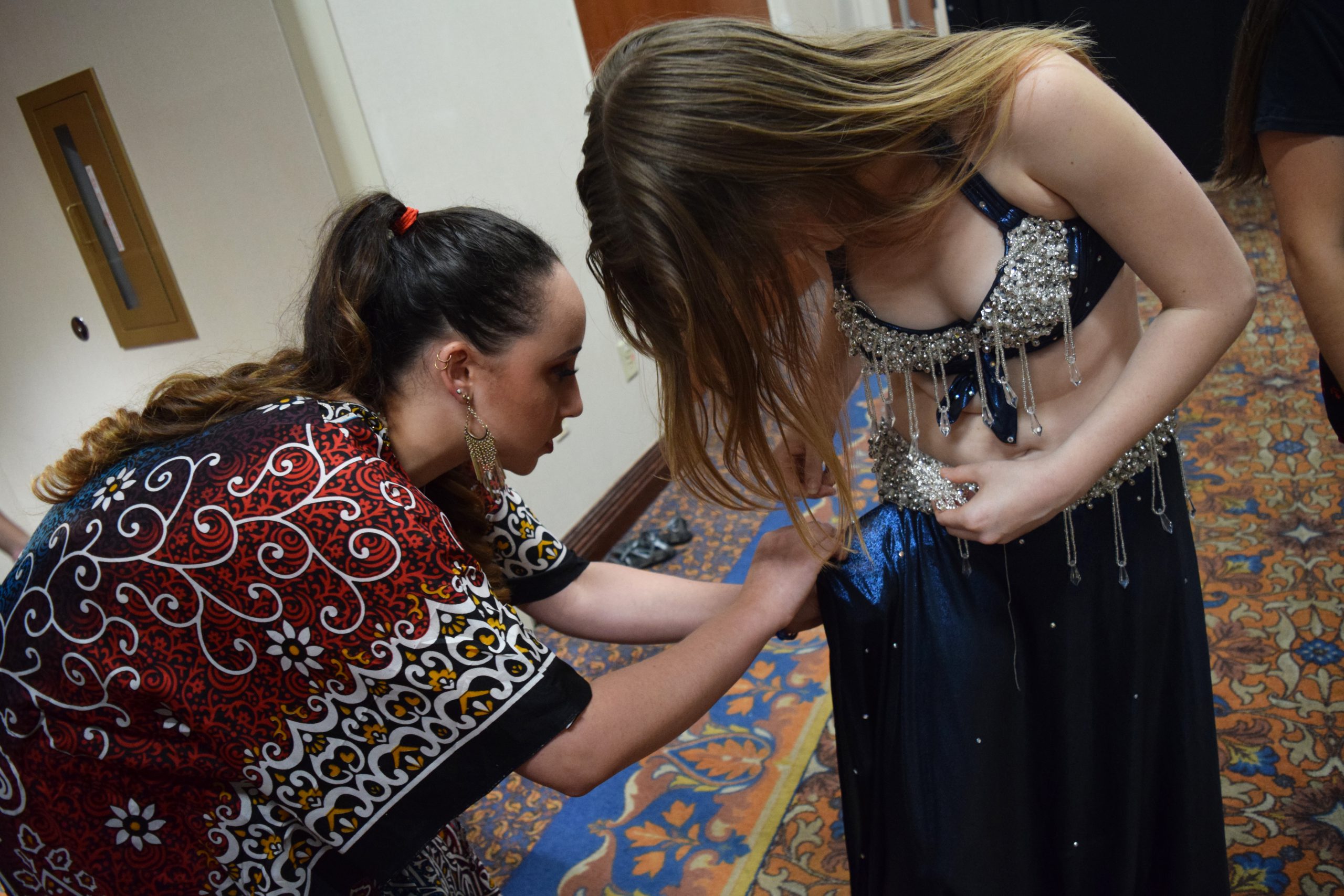
“We’re the Belly Gators, and we’d like to welcome all of you to step into our world. Here’s a little piece of us. We hope you enjoy.”
The applause fades into the start of the first routine, the Adele remix with the fan veils — and as soon as the dancers hit their first shimmy, Macfarlane can’t help but smile.
Standing on the side of the stage as she watches her shimmy sisters, who bring to the dance floor a variety of personalities and physiques, Macfarlane thinks of her beloved teacher, Shayna, who inspired her to never give up on finding her own personal meaning for belly dance. She’s reminded of the timid girl who tried shimmying for the first time and the woman she is today, who owns everything about herself — whether she’s wearing a robe, spandex tights or a sequined bra — and who has inspired so many others along the way, too.
And the best part? It’s just the beginning of the show.
 Special Report from WUFT News
Special Report from WUFT News